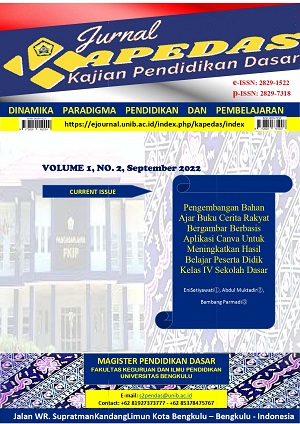Main Article Content
Abstract
Abstract This study aims to describe the development, feasibility, and determine the effectiveness of the AKM-oriented HOTS question formulation module in elementary science subjects and to determine student literacy achievements in answering AKM-oriented HOTS questions in elementary science subjects. This research is a development research using the ADDIE model. Analysis of teacher needs for the module, initial module design, module development, module implementation, and evaluation. Data were collected through surveys, documentary analysis, teacher response interviews, and student literacy tests. The survey was conducted using a questionnaire to determine the teacher's needs for the HOTS question preparation module. The instruments used are expert validation instruments, question analysis instruments, and test instruments to determine student literacy achievements. The results of this study are the compilation of HOTS questions that are feasible to use as evidenced by the value of the material expert's reliability test results of 0.58, media experts 0.435, and linguists 0.696. The module is effective for improving the ability of teachers in preparing HOTS questions as evidenced by the T-Test score with a significance level of 0.04 (p < 0.05).
Article Details
Copyright (c) 2022 Rima Yanti Z

This work is licensed under a Creative Commons Attribution-ShareAlike 4.0 International License.

Karya ini dilisensikan di bawah Creative Commons Attribution-ShareAlike 4.0 International License .
References
- Aiken, L.R. (1985). Three Coefficients for Analyzing the Reliability and Validity of Ratings.Educational and Psychological easurement, 45 (1), 131-142
- Azwar, S. (2000). Tes Prestasi. Yogyakarta: Pustaka Pelajar.
- Dwisetiarezi, D dan Fitria,F. (2021). Analisis Kemampuan Literasi Sains Siswa pada Pembelajaran IPA Terintegrasi di Sekolah Dasar.Jurnal Basicedu. 5 (4), 1958-1967 diunduh 24 April 2022, dari:https://jbasic.org/index.php/basicedu/article/view/1136
- Fleiss, J. L. (1975). Measuring Agreement between Two Judges on the Presence or Absence of a Trait. Biometrics, 3(1), 651 ‐ 659.
- Herminayu dan Sulasmono, B.S. (2020).Pengembangan Modul Pelatihan Model Pembelajaran BCCT Bagi Guru dan Kepala Taman Kanak-Kanak. Jurnal Obsesi : Jurnal Pendidikan Anak Usia Dini. 4 (2), 1112-1123. Diunduh 14 April 2022dari
- https://obsesi.or.id/index.php/obsesi/article/view/512/pdf
- Kemdikbudristek. (2021). Modul Literasi Sains Di Sekolah Dasar. Jakarta. Dirjend Pauddikdasmen
- Koto, I., Susanta, A., Winarni, E.W. (2020). Peningkatan Kompetensi Pedagogik Guru Sekolah Dasar Tentang Tes Keterampilan Berfikir Tingkat Tinggi Higher Order Thingking Skill. Jurnal Abdi Pendidikan, 1(2), 110
- Prasetya, Indra, I. (2012). Meningkatkan Keterampilan Menyusun Instrumen Hasil Belajar Berbasis Modul Interaktif Bagi Guru-Guru IPA SMPN Kota Magelang.Journal of Research and Educational Research e valuation, 1 (2), 106-112.
- Purnomo, E & Nugraheni, T. (2019).Pengembangan Modul Tari Berbasis Digital untuk Meningkatkan Kompetensi Guru Sekolah Menengah Tari.Gondang Jurnal Seni dan Budaya, 5(2), 119-127.
- Purwanto, N.M. (2008). Prinsip-Prinsip dan Teknik Evaluasi Pengajaran. Bandung: Rosdakarya
- Sukmadinata, N.S. (2007). Metode Penelitian Pendidikan. Jakarta: Remaja Rosdakarya.
- Winarni, E.W. (2018). Penelitian Kuantitatif dan Kualitatif. Jakarta: Bumi Aksara.
References
Aiken, L.R. (1985). Three Coefficients for Analyzing the Reliability and Validity of Ratings.Educational and Psychological easurement, 45 (1), 131-142
Azwar, S. (2000). Tes Prestasi. Yogyakarta: Pustaka Pelajar.
Dwisetiarezi, D dan Fitria,F. (2021). Analisis Kemampuan Literasi Sains Siswa pada Pembelajaran IPA Terintegrasi di Sekolah Dasar.Jurnal Basicedu. 5 (4), 1958-1967 diunduh 24 April 2022, dari:https://jbasic.org/index.php/basicedu/article/view/1136
Fleiss, J. L. (1975). Measuring Agreement between Two Judges on the Presence or Absence of a Trait. Biometrics, 3(1), 651 ‐ 659.
Herminayu dan Sulasmono, B.S. (2020).Pengembangan Modul Pelatihan Model Pembelajaran BCCT Bagi Guru dan Kepala Taman Kanak-Kanak. Jurnal Obsesi : Jurnal Pendidikan Anak Usia Dini. 4 (2), 1112-1123. Diunduh 14 April 2022dari
https://obsesi.or.id/index.php/obsesi/article/view/512/pdf
Kemdikbudristek. (2021). Modul Literasi Sains Di Sekolah Dasar. Jakarta. Dirjend Pauddikdasmen
Koto, I., Susanta, A., Winarni, E.W. (2020). Peningkatan Kompetensi Pedagogik Guru Sekolah Dasar Tentang Tes Keterampilan Berfikir Tingkat Tinggi Higher Order Thingking Skill. Jurnal Abdi Pendidikan, 1(2), 110
Prasetya, Indra, I. (2012). Meningkatkan Keterampilan Menyusun Instrumen Hasil Belajar Berbasis Modul Interaktif Bagi Guru-Guru IPA SMPN Kota Magelang.Journal of Research and Educational Research e valuation, 1 (2), 106-112.
Purnomo, E & Nugraheni, T. (2019).Pengembangan Modul Tari Berbasis Digital untuk Meningkatkan Kompetensi Guru Sekolah Menengah Tari.Gondang Jurnal Seni dan Budaya, 5(2), 119-127.
Purwanto, N.M. (2008). Prinsip-Prinsip dan Teknik Evaluasi Pengajaran. Bandung: Rosdakarya
Sukmadinata, N.S. (2007). Metode Penelitian Pendidikan. Jakarta: Remaja Rosdakarya.
Winarni, E.W. (2018). Penelitian Kuantitatif dan Kualitatif. Jakarta: Bumi Aksara.
